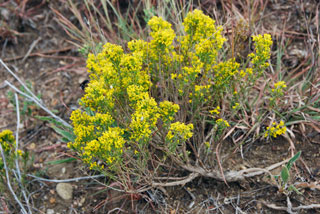BROOM SNAKEWEED
|
 |
| File Size: 146 KB |
|
|
|
Gutierrezia sarothrae (Pursh ) Britton & Rusby
|
| Kiowa County, Kansas |
| Perennial |
| Height: 8-40 inches (usually less than 20 inches) |
| Family: Asteraceae - Sunflower Family |
| Flowering Period: August, September |
|
| Also Called: | | Turpentine weed. | | Stems: | | Erect to ascending, several to many, bushy-branching from base, woody. | | Leaves: | | Alternate, simple, sessile, linear to nearly filiform, .5 to 2.5 inches long, less than 1/8 inch wide, midrib prominent; margins entire, sometimes rolling inward. | | Inflorescences: | | Numerous clusters of 2-5 heads, terminal; bracts narrow, green at tips and along mid-nerves. | | Flowers: | | Ray florets 3-8, less than 1/8 inch long, yellow; disk florets 2-6, yellow. | | Fruits: | | Achenes, short, finely hairy, brown, tipped with 8-10 pointed, whitish scales, enclosing small seed. | | Habitat: | | Dry, open prairies, uplands, disturbed rocky or barren sites, most abundant in sandy and clay loam soils. | | Distribution: | | West 1/2 of Kansas. | | Toxicity: | | Toxic to cattle and sheep. When consumed at particular times during pregnancy, it can cause abortions or weak calves and lambs. | | Forage Value: | | Broom snakeweed is unpalatable to livestock, and they will not consume it unless other forage is unavailable. | | Uses: | | Native Americans used broom snakeweed to treat colds, coughs, respiratory difficulties, snakebites, and insect stings. | | Comments: | | Forb or subshrub. Broom snakeweed often is observed in overgrazed pastures. The name "turpentine weed" alludes to the pine-like odor of crushed plants. |
|
| Broom snakeweed inflorescences |  | | 106 KB | | Russell County, Kansas |
| | Broom snakeweed |  | | 183 KB | | Russell County, Kansas |
| | Broom snakeweed |  | | 140 KB | | Russell County, Kansas |
| | Broom snakeweed |  | | 86 KB | | Kiowa County, Kansas |
| | Broom snakeweed |  | | 160 KB | | Kiowa County, Kansas |
| | Broom snakeweed flowers |  | | 99 KB | | Russell County, Kansas |
| | Broom snakeweed |  | | 344 KB | | Russell County, Kansas |
| | | |
|
|
|
|
|
|